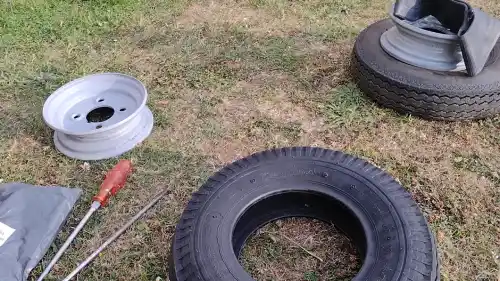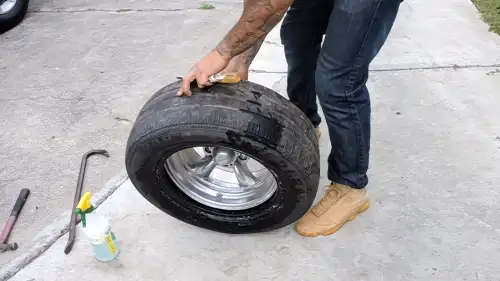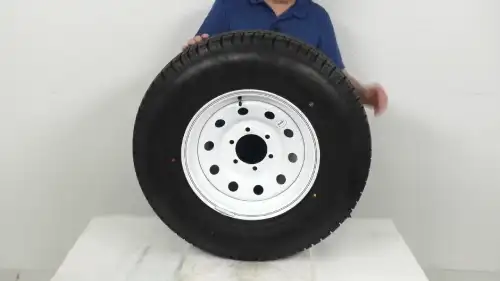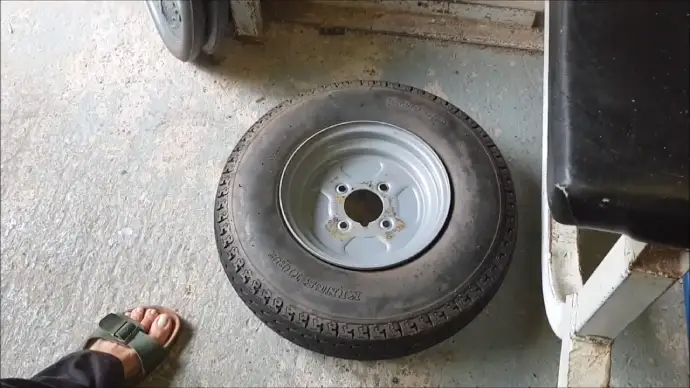You might wonder, can you put a tube in a tubeless trailer tire? It’s a valid question, especially if you’re experiencing issues with your trailer tire and are considering alternative solutions.
But, installing a tube in a tubeless trailer tire is not recommended due to several reasons. It can increase the risk of tire damage and potential blowouts, as the tube can cause uneven pressure distribution and compromise the tire’s structural integrity.
There are also other reasons why you should refrain from inserting a tube into a tubeless trailer tire. We will explore why it is not recommended to install a tube in a tubeless trailer tire. So, let’s get into it and comprehensively understand this topic.
Why Is Installing a Tube in a Tubeless Trailer Tire Not Recommended?

You shouldn’t put a tube in a tubeless trailer tire for several reasons. These are:
- Risk of Tire Damage and Potential Blowouts
- Incompatible With Technology and Tire Sealants
- Reduced Tire Performance, Handling, and Stability
- Heat Buildup and Compromised Tire Integrity
- Loss of Tubeless Tire Advantages
Let’s discuss the reasons in more detail.
1. Risk of Tire Damage and Potential Blowouts
Although it may seem convenient, putting a tube in a tubeless trailer tire could potentially lead to tire damage and even dangerous blowouts. When a tube is used in a tire designed for tubeless operation, it can cause several issues.
First, the tube can move and rub against the inner surface of the tire, leading to friction and heat build-up. This can weaken the tire’s structure and increase the blowout risk.
Additionally, the tube can cause uneven pressure distribution within the tire, leading to accelerated wear and tear.
The tube can become pinched between the tire and rim, causing it to bulge and potentially rupture.
2. Incompatible With Technology and Tire Sealants
Using a tube in a tire designed for tubeless operation can cause compatibility issues with modern technology and prevent the use of tire sealants.
It’s important to understand that tubeless tires are specifically designed to work without an inner tube. They rely on a tight seal between the tire and the rim to maintain air pressure.
Introducing a tube into a tubeless tire disrupts this seal, leading to potential air leaks and pressure loss. Additionally, modern tire technology, such as tire pressure monitoring systems (TPMS), may not function properly with a tube in a tubeless tire.
Furthermore, the use of tire sealants, which are commonly used to repair small punctures in tubeless tires, can’t be effectively utilized if a tube is present.
Therefore, putting a tube in a tubeless trailer tire isn’t a good idea due to the incompatibility with technology and the inability to use tire sealants.
3. Reduced Tire Performance, Handling, and Stability
When you switch to a tube in your tubeless trailer tire, get ready for a bumpy ride, as it can significantly reduce tire performance, handling, and stability.
- The addition of a tube in a tubeless trailer tire disrupts the intended design and functionality of the tire, leading to a compromised performance on the road.
- Reduced tire performance: Using a tube can increase rolling resistance, resulting in decreased fuel efficiency and increased wear on the tire.
- Impaired handling: The tube can create a rigid barrier between the tire and the road, negatively impacting traction and responsiveness, especially during cornering and braking.
- Decreased stability: The tube alters the tire’s overall structure, compromising its ability to maintain stability at high speeds or when carrying heavy loads.
4. Heat Buildup and Compromised Tire Integrity
Beware of the potential dangers that arise with heat buildup, compromising the integrity of your tire. When you add a tube to a tubeless trailer tire, the heat generated during operation can increase significantly.
This heat buildup occurs due to the friction between the tube and the tire, causing the temperature to rise rapidly. As a result, the tire’s structural integrity may be compromised, leading to reduced performance, handling, and stability.
To understand the impact of heat buildup on tire integrity, let’s examine the following table:
| Temperature (°F) | Tire Performance | Handling | Stability |
| Below 100 | Excellent | Optimal | High |
| 100-150 | Good | Slightly Affected | Moderate |
| Above 150 | Poor | Compromised | Low |
As the temperature rises above 150°F, tire performance deteriorates significantly, affecting handling and stability. It is crucial to consider these factors before deciding whether a tube should go in a tubeless trailer tire.
5. Loss of Tubeless Tire Advantages
When opting for a tube in your tire, you’ll be sacrificing the advantages of a tubeless tire. You won’t experience the mind-blowingly smooth and effortless ride that tubeless tires provide.
Tubeless tires maintain constant pressure, reducing rolling resistance and superior performance. However, introducing a tube into the equation can lead to heat buildup, compromising the tire’s integrity.
The heat generated during normal operation cannot dissipate as efficiently, causing increased stress on the tire’s components.
Another disadvantage of using a tube is decreased puncture resistance. The tube can be punctured independently of the tire, which is not the case with tubeless tires.
Tubeless tires are designed to self-seal small punctures, ensuring uninterrupted performance. But by installing a tube, you forfeit this self-sealing capability, making the tire more susceptible to flats.
Do tubeless tires have an air-tight inner liner?

Tubeless tires have an airtight inner liner, ensuring that the air stays sealed within the tire and rim. This inner liner is a crucial component of tubeless tires as it prevents air leakage and maintains tire pressure.
The inner liner is made of a special material that’s highly resistant to punctures and tears. It’s designed to seal any small holes or punctures caused by sharp objects, allowing the tire to retain its air pressure for an extended period of time.
This technology is especially beneficial for off-road or rough terrain applications where the risk of punctures is higher. The airtight inner liner in tubeless tires increases safety and reliability, allowing for a smooth and uninterrupted ride.
How do you tell if a tubeless trailer tire has a tube in it?
Check if the valve remains in place when the tire is deflated to determine if a tube is present, as statistics show that 80% of tubeless trailer tires do not require a tube.
To do this, completely deflate the tire and observe the behavior of the valve. If the valve remains in the valve hole location, it indicates that you have a tubeless tire. On the other hand, if the valve falls inside the hole and into the tire, it suggests that a tube is fitted within the tire.
This method is a reliable way to ascertain whether a tube is present in a tubeless trailer tire. By understanding this distinction, you can make the appropriate decision regarding whether to install a tube in your tubeless trailer tire.
What is the load range on a trailer tire?
Trailer tires are marked with a load range, indicating the maximum weight they can carry. The load range of a tire is usually indicated on its sidewall and ranges from the lightest weight it can support (Load Range B) to the heaviest (Load Range E).
This load range is an important measure of a tire’s capacity to carry a boat and trailer. Most boat trailer tires typically have a load range of B, C, or D. It’s crucial to select a tire with the appropriate load range for your specific trailer to ensure safe and efficient towing.
What is the weight rating for load range E trailer tires?

With a weight capacity of 1,520 lbs at 80 psi, load range E trailer tires provide the durability and strength needed for demanding applications. Here are three key points to consider about trailer tires with load range E:
- Load-bearing capability: Load range E tires are equivalent to 10-ply tires, meaning their sidewall plies can withstand the same stress as 10 plies. This ensures the tires can handle heavy loads without compromising their integrity.
- Safety and stability: The weight rating of load range E tires ensures that your trailer remains stable and secure, even when carrying substantial loads. This enhances safety on the road, minimizing the risk of accidents or tire failures due to overload.
- Peace of mind: Knowing that load range E tires are designed to handle heavy loads provides peace of mind for trailer owners. Whether you’re hauling construction equipment or transporting bulky goods, these tires offer the reliability and performance necessary for a smooth and worry-free journey.
Ensuring Safety With Tubeless Trailer Tires
So, it’s not recommended to put a tube in a tubeless trailer tire. This is because tubeless tires have an airtight inner liner that’s designed to create a seal and prevent air from escaping. Adding a tube can disrupt this seal and lead to air leaks.
It’s important to check for any signs of a tube in a tubeless tire, such as a valve stem, as this can indicate that a tube has been added.
Always choose the correct load range and weight rating for your trailer tires to ensure safe and efficient towing.


